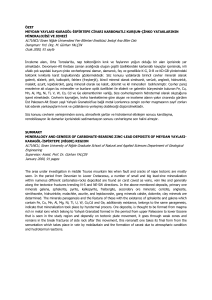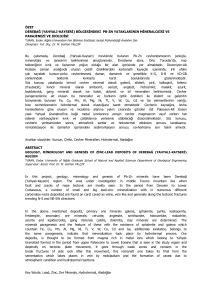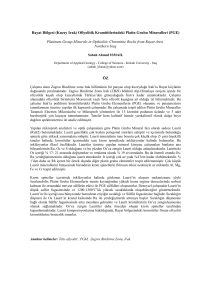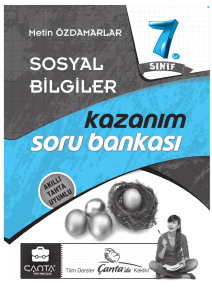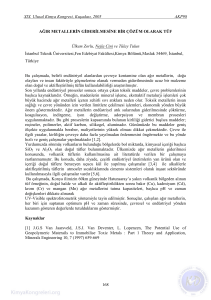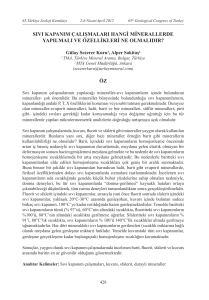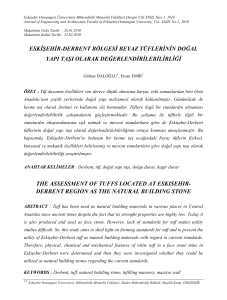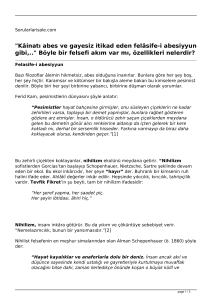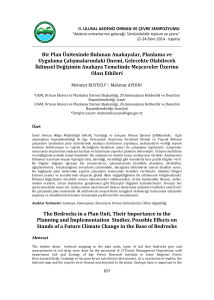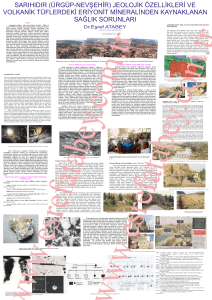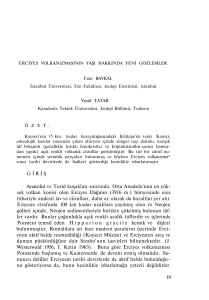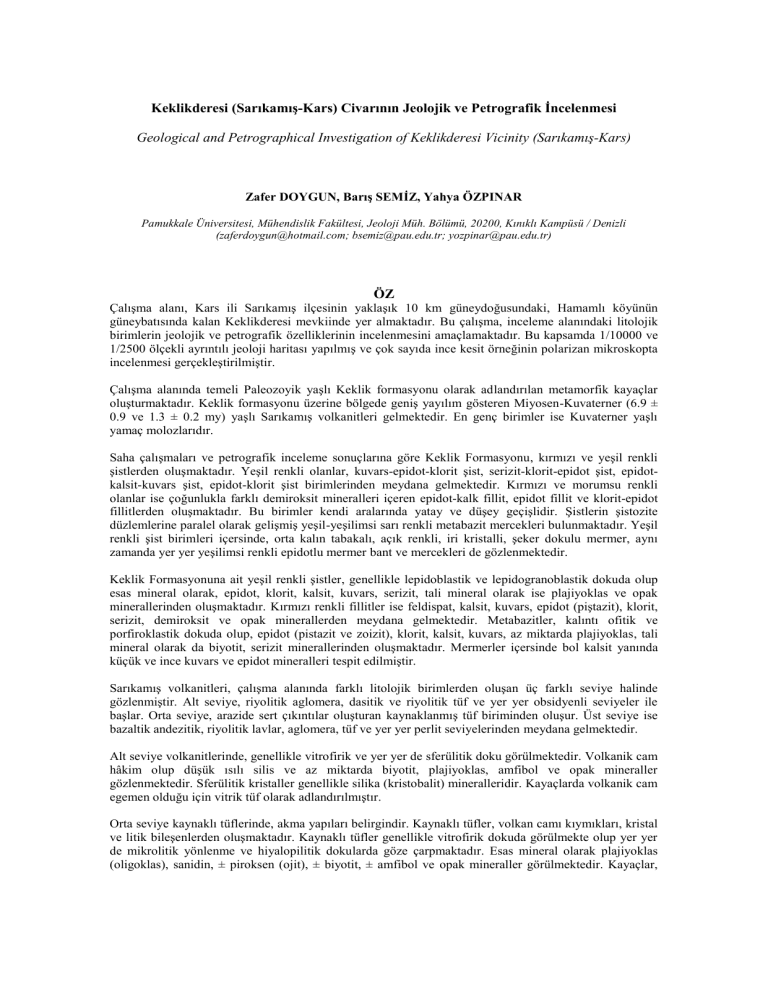
Keklikderesi (Sarıkamış-Kars) Civarının Jeolojik ve Petrografik İncelenmesi
Geological and Petrographical Investigation of Keklikderesi Vicinity (Sarıkamış-Kars)
Zafer DOYGUN, Barış SEMİZ, Yahya ÖZPINAR
Pamukkale Üniversitesi, Mühendislik Fakültesi, Jeoloji Müh. Bölümü, 20200, Kınıklı Kampüsü / Denizli
([email protected]; [email protected]; [email protected])
ÖZ
Çalışma alanı, Kars ili Sarıkamış ilçesinin yaklaşık 10 km güneydoğusundaki, Hamamlı köyünün
güneybatısında kalan Keklikderesi mevkiinde yer almaktadır. Bu çalışma, inceleme alanındaki litolojik
birimlerin jeolojik ve petrografik özelliklerinin incelenmesini amaçlamaktadır. Bu kapsamda 1/10000 ve
1/2500 ölçekli ayrıntılı jeoloji haritası yapılmış ve çok sayıda ince kesit örneğinin polarizan mikroskopta
incelenmesi gerçekleştirilmiştir.
Çalışma alanında temeli Paleozoyik yaşlı Keklik formasyonu olarak adlandırılan metamorfik kayaçlar
oluşturmaktadır. Keklik formasyonu üzerine bölgede geniş yayılım gösteren Miyosen-Kuvaterner (6.9 ±
0.9 ve 1.3 ± 0.2 my) yaşlı Sarıkamış volkanitleri gelmektedir. En genç birimler ise Kuvaterner yaşlı
yamaç molozlarıdır.
Saha çalışmaları ve petrografik inceleme sonuçlarına göre Keklik Formasyonu, kırmızı ve yeşil renkli
şistlerden oluşmaktadır. Yeşil renkli olanlar, kuvars-epidot-klorit şist, serizit-klorit-epidot şist, epidotkalsit-kuvars şist, epidot-klorit şist birimlerinden meydana gelmektedir. Kırmızı ve morumsu renkli
olanlar ise çoğunlukla farklı demiroksit mineralleri içeren epidot-kalk fillit, epidot fillit ve klorit-epidot
fillitlerden oluşmaktadır. Bu birimler kendi aralarında yatay ve düşey geçişlidir. Şistlerin şistozite
düzlemlerine paralel olarak gelişmiş yeşil-yeşilimsi sarı renkli metabazit mercekleri bulunmaktadır. Yeşil
renkli şist birimleri içersinde, orta kalın tabakalı, açık renkli, iri kristalli, şeker dokulu mermer, aynı
zamanda yer yer yeşilimsi renkli epidotlu mermer bant ve mercekleri de gözlenmektedir.
Keklik Formasyonuna ait yeşil renkli şistler, genellikle lepidoblastik ve lepidogranoblastik dokuda olup
esas mineral olarak, epidot, klorit, kalsit, kuvars, serizit, tali mineral olarak ise plajiyoklas ve opak
minerallerinden oluşmaktadır. Kırmızı renkli fillitler ise feldispat, kalsit, kuvars, epidot (piştazit), klorit,
serizit, demiroksit ve opak minerallerden meydana gelmektedir. Metabazitler, kalıntı ofitik ve
porfiroklastik dokuda olup, epidot (pistazit ve zoizit), klorit, kalsit, kuvars, az miktarda plajiyoklas, tali
mineral olarak da biyotit, serizit minerallerinden oluşmaktadır. Mermerler içersinde bol kalsit yanında
küçük ve ince kuvars ve epidot mineralleri tespit edilmiştir.
Sarıkamış volkanitleri, çalışma alanında farklı litolojik birimlerden oluşan üç farklı seviye halinde
gözlenmiştir. Alt seviye, riyolitik aglomera, dasitik ve riyolitik tüf ve yer yer obsidyenli seviyeler ile
başlar. Orta seviye, arazide sert çıkıntılar oluşturan kaynaklanmış tüf biriminden oluşur. Üst seviye ise
bazaltik andezitik, riyolitik lavlar, aglomera, tüf ve yer yer perlit seviyelerinden meydana gelmektedir.
Alt seviye volkanitlerinde, genellikle vitrofirik ve yer yer de sferülitik doku görülmektedir. Volkanik cam
hâkim olup düşük ısılı silis ve az miktarda biyotit, plajiyoklas, amfibol ve opak mineraller
gözlenmektedir. Sferülitik kristaller genellikle silika (kristobalit) mineralleridir. Kayaçlarda volkanik cam
egemen olduğu için vitrik tüf olarak adlandırılmıştır.
Orta seviye kaynaklı tüflerinde, akma yapıları belirgindir. Kaynaklı tüfler, volkan camı kıymıkları, kristal
ve litik bileşenlerden oluşmaktadır. Kaynaklı tüfler genellikle vitrofirik dokuda görülmekte olup yer yer
de mikrolitik yönlenme ve hiyalopilitik dokularda göze çarpmaktadır. Esas mineral olarak plajiyoklas
(oligoklas), sanidin, ± piroksen (ojit), ± biyotit, ± amfibol ve opak mineraller görülmektedir. Kayaçlar,
kristal vitrik tüf olarak adlandırılmıştır. Kaynaklı tüf örnekleri kristal parçalar yanında az miktarda da litik
bileşenler de içermektedir.
Üst seviye tüfleri, volkan camı, kristal ve litik bileşenlerden oluşmaktadır. Tüfler genellikle vitrofirik
dokuda görülmekte olup yer yer de mikrolitlerde yönlenme göze çarpmaktadır. Esas mineral olarak,
plajiyoklas (oligoklas) ve piroksen (ojit) mikrolitleri, ± sanidin, ± biyotit ve opak mineraller tespit
edilmiştir. Litik parçalar genellikle hipokristalin dokudadır. İnce taneli kristaller matriksi oluşturan
volkanik cam içinde dağılmış olarak görülürler. Tüf örnekleri genellikle kristal vitrik tüf ve vitrik tüf
olarak adlandırılmıştır. Üst seviye lav örneklerinde ise hakim doku pilotaksitik ve hiyalopilitik dokudur
yer yer de mikrolitik pilotaksitik dokuda gözlenmektedir. Sanidin ve piroksenler (ojit) fenokristal olarak
bulunmaktadır. Mikrolitler halinde, plajiyoklas, piroksen, opasitleşmiş biyotit ve opak minerallerde
gözlenmektedir. Kayaçların yapılan adlamalarında andezitik ve trakiandezitik lav oldukları belirlenmiştir.
Keklik formasyonu içersinde yer yer cevherli zonların yer aldığı belirlenmiştir. Cevherleşme, K5268oD/15-45o KB duruşlu olan şiştozite düzlemlerine paralel süreksizlik yüzeyleri boyunca yerleşmiştir.
Cevher parajenezinin, malahit, azurit, pirit, kalkopirit ve hematit minerallerinden oluştuğu belirlenmiştir.
Anahtar Kelimeler: Sarıkamış, Keklik Formasyonu, Petrografi
ABSTRACT
The study area is located in Keklikderesi in southwestern of Hamamlı village where is approximately 10
km from southeast of Sarıkamış settlement of Kars province. The aim of this study is to determine the
geological and petrographical features of lithological units in the study area. In this study, were made
detailed geological maps (1/10000 and 1/2500 scaled) and prepared numerous thin sections and also
examined under the microscope.
At the basement of the investigated area, Paleozoic aged Keklik formation which is characterized by
metamorphic rocks is situated. Keklik formation is overlain with an angular disconformity by MioceneQuaternary (6.9 ± 0.9 and 1.3 ± 0.2 ma) aged Sarıkamış volcanics. All units in the investigated area are
overlain with an angular conformity by Quaternary aged slope deposits.
According to field observations and petrographical analysis, Keklik formation consists of red and green
schists. Green schists are represented by quartz-epidote-chlorite schist, sericite-chlorite-epidote schist,
epidote-calcite-quartz schist and epidote-chlorite schist units. Red and purplish schists are usually
constituted from epidote-calk phyllite, epidote phyllite and chlorite-epidote phyllite units. The boundary
between the red and green schists is transitive. In the schists had been found green-greenish yellow
metabasites lensoidal shape which developed parallel to the schistosity planes. In the green schist units,
light colored and lensoidal shape white marbles and greenish epidote marbles are also found. They have
sugar texture and with large crystals.
Green schists belonging to Keklik formation are usually lepidoblastic and lepidogranoblastic textures.
They consist of epidote, chlorite, calcite, quartz, sericite, plagioclase and opaque minerals. Red phyllites,
consist of feldspars, calcite, quartz, epidote (pistacite), chlorite, sericite, iron oxide and opaque minerals.
Metabasites are residual ophitic and porphyroclastic textures and consist of epidote (pistacite and
zoisite), chlorite, calcite, quartz and little amount of plagioclase. Secondary minerals contain biotite,
sericite minerals. Marbles consist of abundant calcite, small and fine quartz and epidote minerals.
Sarıkamış volcanics in the investigated area was observed in the three different levels which constituted
from different lithological units. Lower level begin rhyolitic agglomerate, dacitic and rhyolitic tuffs and
in places obsidian levels. Middle level consists of welded tuffs which constituted hard protrusions in land.
Upper level consists of basaltic andesitic, rhyolitic lavas, agglomerate, tuff and in places perlite levels.
In the lower level, volcanics have usually vitrophyric and spherulitic textures. This volcanics contain
abundant volcanic glass and also consist of low temperature silica and little amount biotite, plagioclase,
amphibole and opaque minerals. Spherulitic crystals are usually silica (cristobalite) minerals. Welded
tuffs samples named as vitric tuff for dominant volcanic glass in the rocks.
In the middle level, welded tuffs are evident to flow banding structure. Welded tuffs consist of shards,
crystal and lithic components. Welded tuffs are found usually in the vitrophyric texture, in addition they
have a microlitic flow banding and hyalopilitic textures. These tuffs named as crystal vitric tuff consist of
plagioclase (oligoclase), sanidine, ± pyroxene (augite), ± biotite, ± amphibole and opaque minerals. In
the welded tuff samples had been contained crystal fragments and lithic component in the little amount.
Upper level tuffs consist of volcanic glass, crystal and lithic components. Tuffs are usually in the
vitrophyric texture, also there is a microlitic flow banding texture. In the tuffs had determined plagioclase
(oligoclase) and pyroxene (augite) microlits, ± sanidine, ± biotite and opaque minerals as main mineral.
Lithic fragments are generally hypocrystaline texture. Fine crystals had spread in the volcanic glass. Tuff
samples were named as crystal vitric tuff and vitric tuff. In the upper level lava samples show pilotaksitic,
hyalopilitic and microlitic pilotaksitic texture. Sanidine and pyroxene are found as phenocrystal in the
tuffs which consist of plagioclase, pyroxene, opacited biotite and opaque minerals in the microlits. These
rocks were named as andesitic and trachyandesitic lava according to thin section investigations.
Ore zones are determined in Keklik formation. Ore deposition had ensconced throughout parallel
discontinuities in the N52-68oE/15-45o NW trending schistosity planes. Ore paragenesis are malachite,
azurite, pyrite, chalcopyrite and hematite.
Keywords: Sarıkamış, Keklik Formation, Petrography

